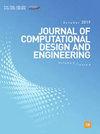增强Schapery理论中嵌入深度神经网络的纤维增强层合板渐进失效分析
IF 6.1
2区 工程技术
Q1 COMPUTER SCIENCE, INTERDISCIPLINARY APPLICATIONS
引用次数: 0
摘要
摘要碳纤维增强聚合物复合材料(CFRP)的计算渐进失效分析(PFA)在现代轻量化航空结构的结构完整性和损伤容限验证和验证过程中具有重要意义。增强Schapery理论(Enhanced Schapery Theory, EST)已经发展并应用于预测各种复合材料结构的损伤模式和承载能力。本文采用深度神经网络(DNN)模型对EST进行增强,可以快速准确地预测任意复合材料层合板在任意应力状态下的基体开裂角。DNN模型由TensorFlow基于源自Mohr-Coulomb失效理论的损伤起裂准则生成的数据进行训练。EST-DNN模型应用于裸眼张压(OHT/OHC)问题。EST-DNN模型的结果在精度上没有损失。所提出的结果结合了机器学习工具带来的高效和准确的预测能力以及EST有限元模型的鲁棒性和用户友好性。本文章由计算机程序翻译,如有差异,请以英文原文为准。
Embedding Deep Neural Network in Enhanced Schapery Theory for Progressive Failure Analysis of Fiber Reinforced Laminates
Abstract Computational progressive failure analysis (PFA) of carbon fiber reinforced polymer composites (CFRP) is of vital importance in the verification and validation process of the structural integrity and damage tolerance of modern lightweight aeronautical structures. Enhanced Schapery Theory (EST) has been developed and applied to predict the damage pattern and load-bearing capacity of various composite structures. In this paper, EST is enhanced by a deep neural network (DNN) model, which enables fast and accurate predictions of matrix cracking angles under arbitrary stress states of any composite laminate. The DNN model is trained by TensorFlow based on data generated by a damage initiation criterion, which originates from the Mohr-Coulomb failure theory. The EST-DNN model is applied to open-hole tension/compression (OHT/OHC) problems. The results from the EST-DNN model are obtained with no loss in accuracy. The results presented combine the efficient and accurate predicting capabilities brought by machine learning tools and the robustness and user-friendliness of the EST finite element model.
求助全文
通过发布文献求助,成功后即可免费获取论文全文。
去求助
来源期刊

Journal of Computational Design and Engineering
Computer Science-Human-Computer Interaction
CiteScore
7.70
自引率
20.40%
发文量
125
期刊介绍:
Journal of Computational Design and Engineering is an international journal that aims to provide academia and industry with a venue for rapid publication of research papers reporting innovative computational methods and applications to achieve a major breakthrough, practical improvements, and bold new research directions within a wide range of design and engineering:
• Theory and its progress in computational advancement for design and engineering
• Development of computational framework to support large scale design and engineering
• Interaction issues among human, designed artifacts, and systems
• Knowledge-intensive technologies for intelligent and sustainable systems
• Emerging technology and convergence of technology fields presented with convincing design examples
• Educational issues for academia, practitioners, and future generation
• Proposal on new research directions as well as survey and retrospectives on mature field.
 求助内容:
求助内容: 应助结果提醒方式:
应助结果提醒方式:


